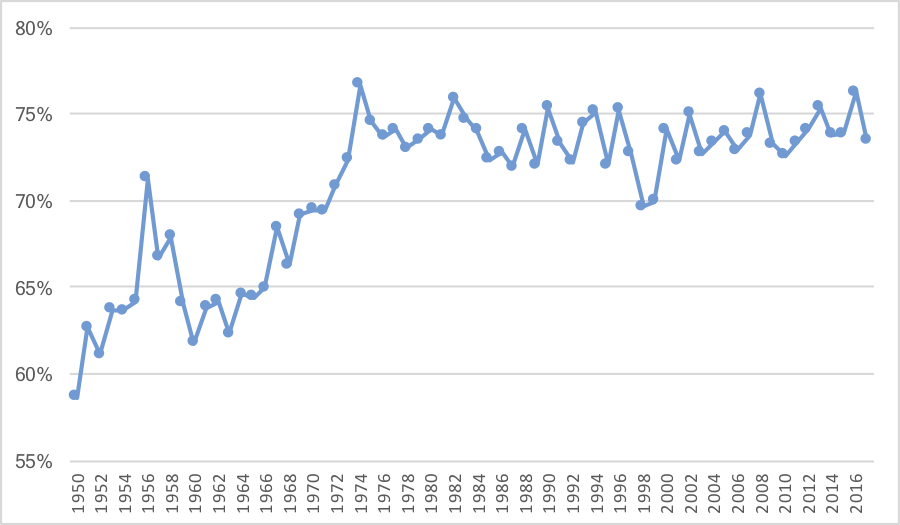by Chase Stuart
on August 15, 2018
As noted yesterday, red zone performance is mildly correlated with team success. One team that was a big outlier last year was the Steelers. Pittsburgh’s offense made it into the red zone 63 times, but converted those trips into touchdowns just 32 times (50.8%), slightly below-average. On defense, the Steelers allowed touchdowns on 24 of 39 red zone trips, a 61.5% rate that was the 5th-worst in the league. Of course, the Steelers were actually one of the best teams in the league.
On one hand, this seems kind of silly: of course red zone performance alone won’t tell us much about a team’s record! It says nothing about a team’s turnover rate, how effective the team is at producing or preventing big plays, overall team efficiency, or special teams. Perhaps the most remarkable part is that it does tell us quite a bit.
The table below has a lot of information, so to analyze it, let’s look at the best red zone team of the modern era, the 2005 Seattle Seahawks. That year, the Seahawks offense had 60 red zone trips and scored a touchdown on 43 of them, a conversion rate of 71.7%. Given that 53% of red zone trips yield a touchdown, this means Seattle’s offense scored 11.1 more red zone touchdowns than expected. On defense, Seattle faced 47 red zone trips, and allowed just 19 touchdowns, a 40.4% conversion rate that was 6.0 touchdowns better than average. Therefore, overall, the team’s red zone performance yielded 17.1 touchdowns better than average, the most of any team since 2002. Based on the best-fit formula derived yesterday, a team’s expected winning percentage based on its red zone team value is 0.0154*(Team Value) +0.500. Since Seattle’s red zone value was +17.1, we would have expected the Seahawks to win 76.3% of their games; they actually won 81.3% of their games, a difference of 0.049.
[continue reading…]
Tagged as:
Red Zone
{ }
by Chase Stuart
on August 14, 2018
On Sunday, I noted that roughly 2/3s of all touchdown passes now come from inside of the red zone. That number is, of course, even higher when we look at all offensive touchdowns. The graph below shows the percentage of passing and rushing touchdowns that came from within the red zone in every year since 1950. Prior to 1970, less than 70% of all touchdowns came from within the red zone; since then, it’s been at about 75%. What’s interesting is that while there is an obvious increase over the course of pro football history, the rate has been relatively steady over the last five decades:
 [continue reading…]
[continue reading…]
Tagged as:
Red Zone
{ }
by Andrew Healy
on September 8, 2014
Football is back. Oh my goodness gracious. Football is back.
The return of football also means the return of TV’s greatest channel and one of the five most important innovations of the 21st century. The Red Zone Channel has simultaneously rendered obsolete commercials, bad games, bad moments of good games, and halitosis. Let’s celebrate with a running diary. Below is what I was thinking as I watched the RedZone through the early games on Sunday.
Allow me to make one gambling note right off the bat. My stone-cold mega-lock of the week was a two-team tease of the Raiders (to +11.5) and the Bears (to -1). I feel completely queasy about the Bears part of this bet. I’m sticking with it, but every instinct in my body is crying out: “Why take Jay Cutler down to 1 point when I can take Peyton Manning down to 2? You know you will regret this.” So if I sound extra emotional about Raiders-Jets and Bills-Bears, that’s why.
One more note: I was writing this as the games were still going on so the time is approximate in some cases. You can pick most of those out by the times that are whole numbers that end in :00 or :30.
Week 1 Red Zone Diaries
Pregame: Ten years of redzone? I didn’t know about this until 2010 or so. Clearly I am getting old. Maybe I’m remembering that wrong, anyway, since I am getting old. Oh so good to see Andrew Siciliano. Is it possible he’s the median man in America? Dark hair, white, average handsomeness, only his ears seem anything other than completely average. If he’s the median man, here’s the Andrew Siciliano of restaurants and the Andrew Siciliano of American incomes. [continue reading…]
Tagged as:
Andrew Healy,
Red Zone,
Week 1
{ }

